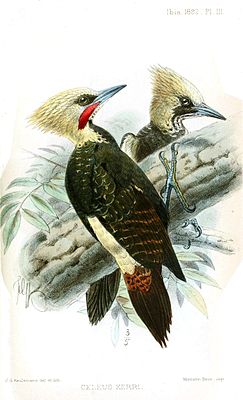Pale-headed woodpecker
| Pale-headed woodpecker | ||||||||||
|---|---|---|---|---|---|---|---|---|---|---|

Pale-headed woodpeckers, males in front, females in back |
||||||||||
| Systematics | ||||||||||
|
||||||||||
| Scientific name | ||||||||||
| Celeus lugubris | ||||||||||
| ( Malherbe , 1851) |

The Pale crested woodpecker ( Celeus lugubris ) is a species of bird from the family of woodpeckers (Picidae). This very small and very contrastingly colored woodpecker has a relatively small distribution area in central South America . The species inhabits open and dry woodlands such as the Chaco and Cerrado and partly deciduous forests. The food mainly sought in the middle stratum of the trees consists of ants and their brood.
The species is not very common, but the world population is estimated to be stable and no serious threats are currently recognizable. The pale-headed woodpecker is therefore classified by the IUCN as safe (“least concern”).
description
Pale-headed woodpeckers are quite small woodpeckers with a very distinctive, long, extended hood. The beak is quite long, slightly pointed in the shape of a chisel, curved downwards at the ridge and comparatively narrow at the base. The body length is about 23–24 cm, the weight 115–157 g. This woodpecker is thus only slightly larger than a woodpecker , but much more difficult than this. The species shows a clear sexual dimorphism in terms of coloration .
In males of the nominate form C. l. lugubris are the upper and middle back as well as the shoulder feathers banded narrowly whitish to yellowish beige on a dark red-brownish-black background. The lower back and rump are light yellow to cream beige, occasionally with a cinnamon hue. The longest upper tail ceilings show a black subterminal spot on a reddish brown background. The blackish upper wing-coverts are banded and lined with whitish to pale beige. The wings are blackish-brown with red-brown banding on the basal half, only the umbrella feathers are completely red-brown banded. The control springs are mostly black on the upper side, only the outermost control springs, which are normally not visible, are spotted black on a red-brown background.
The entire underside of the trunk is dark grayish red-brown, mostly with some bright red-brown feather edges. The flanks become more cream-colored and reddish in the transition area to the rump, the leg fletching is darkly banded to a variable extent on a cream-colored background. The under tail-coverts are black with red-brown banding or speckles. The wings show a pale reddish-brown or cinnamon-colored banding on the underside on a brown background, the axillary feathers and the under wing coverts are cream-colored. The underside of the tail is colored like the top, but less vigorous overall.
Almost the entire head, including the hood, chin and throat, is light yellow to pale beige, sometimes with a shade of cinnamon. The reins, the feathers in front of the nostrils and some feather bases under and behind the eyes are dark brown. The broad stripe of the beard is red, this red coloration can also extend to the forehead and around the eyes.
The upper bill is grayish to horn-colored, the lower bill is lighter or ivory-colored. Legs and toes are gray. The iris is dark red to reddish brown.
Females lack the red streak of beard, this area is banded or scaled brown.
Vocalizations
The only previously known call is described as “wee-wee-week” . The drum rolls are quiet.
distribution and habitat
The pale-headed woodpecker has a relatively small range in central South America . The area extends from north-central Bolivia over the middle Mato Grosso to the south to Paraguay and to the northeast of Argentina . The size of the total distribution area is estimated at 842,000 km².
The species inhabits open and dry woodlands such as the Chaco and Cerrado and partly deciduous forests. It is often observed there in areas with abundance of palm trees.
Systematics
Winkler et al. recognize two poorly differentiated subspecies:
- Celeus l. lugubris ( Malherbe , 1851) - Northern part of the range, east Bolivia and west of Mato Grosso. The subspecies is described above.
- Celeus l. kerri Hargitt , 1891 - Remaining distribution area. Slightly larger and darker than nominate form.
Way of life
The food mainly sought in the middle stratum of the trees consists of ants of the genera Camponotus , Crematogaster , Dolichoderus and other genera as well as their brood. The ants are obtained by poking, reading and chopping, the woodpeckers chop holes in dead wood and catch the ants in their passages with their sticky tongues. The reproduction takes place from September to November, in the south of the distribution area probably also later. The caves are created at a height of 4 to 10 m in trees or in the nests of tree-dwelling ants and termites. Further information on the breeding biology is not yet available.
Existence and endangerment
Estimates of the size of the world population are not yet available. The species is not very common, but the world population is estimated to be stable and no serious threats are currently recognizable. The pale-headed woodpecker is therefore classified by the IUCN as safe (“least concern”).
swell
Individual evidence
- ↑ a b The pale-headed woodpecker at BirdLife International . Retrieved November 25, 2012.
- ↑ Hans Winkler, David A. Christie and David Nurney: Woodpeckers. A Guide to the Woodpeckers, Piculets, and Wrynecks of the World. Pica Press, Robertsbridge 1995: p. 332
literature
- Hans Winkler , David A. Christie and David Nurney: Woodpeckers. A Guide to the Woodpeckers, Piculets, and Wrynecks of the World. Pica Press, Robertsbridge 1995, ISBN 0-395-72043-5 : pp. 128-129 and 332.
Web links
- Celeus lugubris in the endangered Red List species the IUCN 2012. Posted by: BirdLife International, 2012. Accessed November 25, 2012th
Other web links
- Videos, photos and sound recordings of Celeus lugubris in the Internet Bird Collection